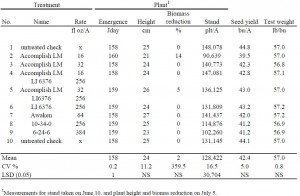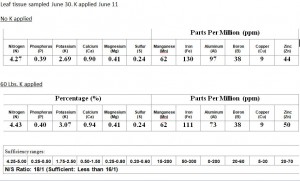Greg Endres and Paul Hendrickson of North Dakota State University conducted a trial using in-furrow fertilizer on soybeans. They gave me permission to share this research.
Click on graph to zoom
Methods for trial:
A field experiment was conducted at the NDSU Carrington Research Extension Center in cooperation with Loveland Products to examine soybean response to selected in-furrow liquid fertilizer sources. Experimental design was a randomized complete block with four replications. The irrigated, conventional-till trial was conducted with wheat as the previous crop on a Heimdal Emrick loam soil with 3.6% organic matter and 7.7 pH. On May 25, inoculated Dairyland Seeds ‘DSR-0401/RR’ were planted at about 167,000 seeds/A in 30-inch rows, and included in-furrow fertilizer. Hail damaged the trial on July 24 and a killing frost occurred on September 14 with soybean generally in the late R6 stage of growth. The trial was harvested with a plot combine on October 3.
Plant emergence was delayed 1 to 2 days with several in-furrow fertilizer treatments (Table). Average plant stand of the untreated checks was 139,600 plants/A. Stand was reduced with Accomplish LM at 16 fl oz/A, while treatments #3 to 7 had stands similar to the untreated checks, probably indicating an application error with treatment #2. Use of 10-34-0 and 6-24-6 generally reduced plant stand compare to untreated checks. Seed yield and test weight were similar among treatments. However, yield with in-furrow fertilizer tended to be slightly reduced compared to the untreated checks. Website address is https://www.ag.ndsu.edu/carringtonrec/documents/agronomyrd/docs2011/2011%20Soybean%20Response%20to%20In-furrow%20Fertilizer.pdf
Soybean Yield With Potassium
I conducted a trial last year looking at additional K sidedress on soybeans. The trial was replicated 3 times at the Vidalia Onion and Vegetable Research Station in Lyons, GA.
Field prep: Harrowed and field cultivated.
Irrigated
Planted May 19 in 36 in. rows with 8.7 seed/ft.
Harvested December 15. (Weather delayed harvest)
K applied sidedress June 11.
Herbicides: Sonalan pre. Dual at planting. Storm, Roundup, and Dual applied June 13.
Previous crop: Cotton
The below graph shows the tissue sample results after the K was applied.
Soil nutrients were sufficient. Soil sample results:
P = 294 lbs./A, K = 281 lbs./A, Ca = 1,631 lbs./A, Mg = 208 lbs./A, Zn = 12 lbs./A, Mn = 27 lbs./A, pH = 6.6
UGA recommendations:
N = 0 lbs/A, P = 0 lbs/A, K = 0 lbs/A
.25 lbs/A Boron
The soil sample did not call for additional K or other nutrients. Where the additional K was applied the yield was slightly lower. We were surprised at the results and expected the K to yield higher. More research on this is needed.
In 2013 I conducted a high yield soybean trial and we made 82 bushels. Results are posted at https://site.extension.uga.edu/applingcrop/2013/10/80-bushel-soybeans/.
The methods used for that trial are listed below:
Planting date: May 22. Harvested: Oct. 28 & 29.
Irrigation: maintained 1 inch of water (rain or irrigation) weekly and increased to 2 inches after bloom through pod fill. Seeding rate: 8.7 seed per foot planted 1 inch deep on 36 inch rows. Soil prep: Disked, ripped and bedded.
Soil sample results: Phosphorus – very high, Potassium – high, Calcium – high, Magnesium – high, Zinc – sufficient, Manganese – Sufficient, pH – 6.7.
UGA recommendations: 70 lbs Potassium and .25 lbs Boron.
Fertilizer: 2 tons chicken litter.
Dimilin and Boron applied between R2 and R3 stage. Belt and Mustang max used for insect control. Weed control: Reflex, Dual Magnum and Round up.
Thoughts and Discussion
Based on the two trials, the chicken litter did yield higher, but these were conducted one year apart and under slightly different conditions. We can’t accurately compare the results. I can say that under the conditions from the 2013 trial using chicken litter produced excellent yields, and in the 2014 trial applying extra K above soil sample recommendations did not improve yields. In the 2013 trial we were only looking at how far yields could be pushed using reasonably economic practices. Therefore, all plots received litter in 2013 and there were no untreated plots to determine how that would have impacted yields.
More research is needed to determine exactly what happened in the trial where only K was applied and to determine what additional nutrients work best for consistently achieving high yields. Would a complete granular fertilizer have yielded as high as the chicken litter? That’s what I plan to look at in 2015.
As of right now, I would recommend following current soil sample recommendations and consider using chicken litter as the fertilizer source for soybeans.


